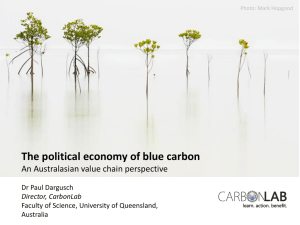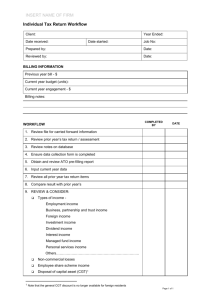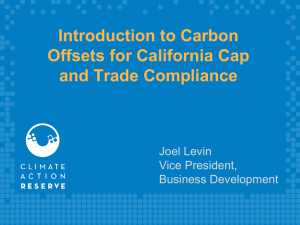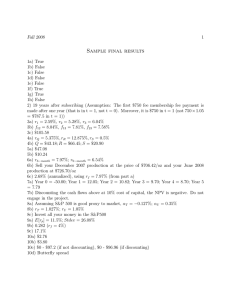Carbon Sequestration in Agricultural Soils: Discounting for Uncertainty Lyubov A. Kurkalova
advertisement
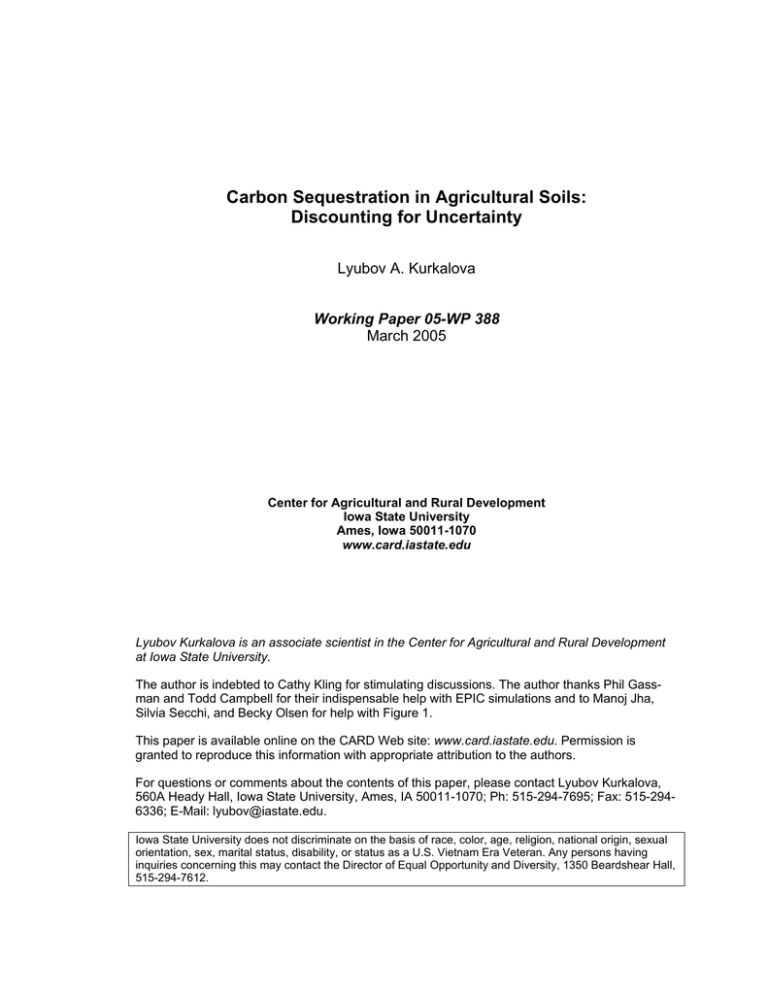
Carbon Sequestration in Agricultural Soils:
Discounting for Uncertainty
Lyubov A. Kurkalova
Working Paper 05-WP 388
March 2005
Center for Agricultural and Rural Development
Iowa State University
Ames, Iowa 50011-1070
www.card.iastate.edu
Lyubov Kurkalova is an associate scientist in the Center for Agricultural and Rural Development
at Iowa State University.
The author is indebted to Cathy Kling for stimulating discussions. The author thanks Phil Gassman and Todd Campbell for their indispensable help with EPIC simulations and to Manoj Jha,
Silvia Secchi, and Becky Olsen for help with Figure 1.
This paper is available online on the CARD Web site: www.card.iastate.edu. Permission is
granted to reproduce this information with appropriate attribution to the authors.
For questions or comments about the contents of this paper, please contact Lyubov Kurkalova,
560A Heady Hall, Iowa State University, Ames, IA 50011-1070; Ph: 515-294-7695; Fax: 515-2946336; E-Mail: lyubov@iastate.edu.
Iowa State University does not discriminate on the basis of race, color, age, religion, national origin, sexual
orientation, sex, marital status, disability, or status as a U.S. Vietnam Era Veteran. Any persons having
inquiries concerning this may contact the Director of Equal Opportunity and Diversity, 1350 Beardshear Hall,
515-294-7612.
Abstract
The study presents a conceptual model of an aggregator who selectively pays
farmers for altering farming practices in exchange for carbon offsets that the change in
practices generates. Under the assumption that the offsets are stochastic and that the
aggregator maximizes the sum of the offsets from the purchase that he/she can rightfully
claim with a specified level of confidence subject to a budget constraint, we investigate
the optimal discounting of expected carbon offsets. We use the model to estimate
empirically the optimal discounting levels and costs for a hypothetical carbon purchasing
project in the Upper Iowa River Basin.
Keywords: carbon sequestration in agricultural soils, offset discounting, uncertainty.
CARBON SEQUESTRATION IN AGRICULTURAL SOILS:
DISCOUNTING FOR UNCERTAINTY
Introduction
Agricultural communities in the United States, Canada, and in a number of other
countries have been excited about the prospect of farmers selling credits for carbon
sequestered in cropland soils as greenhouse gas emission offsets. However, one of the big
practical issues hindering the potential carbon sales is the uncertainty associated with the
offsets. From a buyer’s point of view, future offsets are uncertain because carbon sequestration in agricultural soil is affected by a multitude of factors, many of which, such as
weather and solar radiation, are inherently stochastic.
While there is a growing soil science literature quantifying the uncertainty and its determinants, the topic has received little attention in the economic analyses of carbon
sequestration in cropland (Antle and McCarl 2002). Marland, McCarl, and Schneider
(2001) mention the importance of the uncertainty in the context of proposed carbon
accounting protocols that allow the credits only if there is at least 95 percent certainty
about their magnitude. McCarl, Butt, and Kim (2004) also discuss the importance of the
uncertainty and report the ensuing discounting of carbon offsets at the Chicago Climate
Exchange at about 15 percent. Antle et al. (2003) propose a sampling procedure to reduce
the uncertainty about carbon sequestered, yet neither study investigates how the presence
of uncertainty alters economic agents’ decision making. This study attempts to fill in this
gap by analyzing the mechanism of discounting carbon offsets for uncertainty.
The focus of the current study is an aggregator, the economic agent vital for carbon
trading involving agriculture, as large emitters of greenhouse gases usually need quantities of offsets much larger than any single farm can provide (Thomassin 2003; McCarl,
Butt, and Kim 2004). In a carbon sequestration program administered by a government
agency, the role of the aggregator is also important. In this case, the aggregator would
assemble the offsets for reporting to interested parties such as those representing taxpayers (for domestic programs) or to certify international organizations (for international
2 / Kurkalova
agreements). In any case, because of either market requirements or policy design stipulations, the aggregator may be seriously concerned about the uncertainty of the offsets
being delivered and may adjust behavior accordingly.
This study presents a conceptual model of an aggregator selectively purchasing carbon offsets from farmers who switch farming practices to those that increase soil carbon
content. We assume that the aggregator maximizes the sum of the offsets from the project
that he/she can rightfully claim with a specified level of confidence, subject to a budget
constraint. The model builds on the earlier work on cost-efficiency of achieving probabilistic pollution reduction targets (see, e.g., Shortle and Horan 2001). Empirical
applications of the approach have been limited and almost exclusively focused on water
quality (Milon 1987; Lichtenberg, Zilberman, and Bogen 1989; Bystrom 1998; Shortle et
al. 1999; Bystrom, Andersson, and Gren 2000). In contrast, we build the model specifically to examine expected offset discounting arising because of uncertainty in the amount
of carbon to be sequestered and the aggregator’s concern about confidence bounds on the
total offset. We then apply the model to an empirical study of a hypothetical carbon
sequestration project in the Upper Iowa River Basin.
Conceptual Model
Assume there are N farms indexed by i that can potentially change their current
farming practice to that of sequestering carbon. Let xi denote the size of farm in acres
and let ci be the per acre opportunity cost of farmer changing practice (known to the
aggregator). The farm i per acre offset generated by the change in practice, bi , is stochastic, and because of varying natural conditions (soils and landscape characteristics,
cropping history, etc.), the offset distributions differ potentially from farm to farm, so that
the bi ’s are jointly normally distributed,
b1 σ 11 σ 12 ...σ 1N
b1
b
2 ∼ N b2 , σ 12 σ 22 ...σ 2 N ,
... ...
...
b
σ
σ
...
σ
b
NN
N
N 1N 2 N
where bi ≡ E ( bi ) , σ ii ≡ Var ( bi ) , σ ij ≡ Covar ( bi , b j ) , i, j = 1,..., N .
(1)
Carbon Sequestration in Agricultural Soils: Discounting for Uncertainty / 3
The aggregator is an economic agent who selectively offers farmers payments for
switching the practices in exchange for carbon offsets that the change in practices generates. The aggregator has a budget, C , for these purchases, and for each farmer, i , the
aggregator decides on the number of acres, xi , 0 ≤ xi ≤ xi , on which to offer per acre
payment ci . We assume that as long as a farmer is offered the payment, he/she switches
the practices and the aggregator acquires the offset.
Because of carbon market regulations (or those of the policy if the offset purchasing
is done under auspices of a government-administered policy) the aggregator is concerned
about the certainty of the total offset he/she is getting from the individual purchases.
Specifically, we assume that the aggregator maximizes the amount of the aggregate offset
that can be rightfully claimed with a confidence level α . The confidence level, α , is
typically large and is greater than 0.5. Thus, the aggregator is maximizing the offset
amount B , defined by
N
Pr ∑ bi xi ≥ B = α .
i =1
(2)
N
Under the assumptions (1), the total carbon sequestered in the program,
∑b x
i =1
N
normally distributed with the expected value
∑ bi xi , and variance
i =1
N
i i
, is
N
∑∑ x x σ
i =1 j =1
i
j
ij
. There-
fore, the deterministic equivalent of (2) is
N
B = ∑ bi xi − zα
i =1
N
N
∑∑σ
i =1 j =1
x xj ,
ij i
where zα is the number such that Pr {Z ≤ zα } = α and Z ∼ N ( 0,1) (Charnes and Cooper
1963). Note that if the aggregator is indifferent between falling below and exceeding the
total offset target B , then α = 0.5 and zα = 0 , meaning that aggregator is not making
any adjustments to the uncertainty of the total offset and is simply maximizing the total
expected value of the offsets purchased. However zα > 0 as long as α > 0.5 , implying
4 / Kurkalova
that in this case the aggregator is always discounting the expected value of the total offset
purchased by the amount
N
N
∑∑σ
A ≡ zα
i =1 j =1
x xj .
(3)
ij i
As expected intuitively, the magnitude of discounting increases with the confidence level
α and depends on the variability of offsets as described by their variance-covariance
matrix.
Mathematically, the aggregator’s problem is
N
max ∑ bi xi − zα
x1 ,..., x N
i =1
N
N
∑∑ x x σ
i =1 j =1
i
j
(4)
ij
N
subject to the budget constraint C − ∑ ci xi ≥ 0 , the N land constraints xi − xi ≥ 0 ,
i =1
i = 1,..., N , and the N non-negativity constraints xi ≥ 0, i = 1,..., N .
Let xi* , i = 1,..., N denote the solution to (4), λ * be the Lagrangian multiplier of the
budget constraint at the optimum, and θi* , i = 1,..., N be the Lagrangian multipliers of the
land constraints at the optimum. Then the first-order necessary conditions imply that all
positive xi* satisfy the equation
N
bi − zα ∑ σ ij x*j
j =1
N
N
∑∑σ
i =1 j =1
x x − λ *ci − θi* = 0 .
* *
ij i j
(5)
Intuitively that means that at the optimum, the farm i marginal per acre expected benefit
N
bi is being effectively adjusted by the amount ai* ≡ zα ∑ σ ij x *j
j =1
N
N
∑∑σ
i =1 j =1
* *
ij i j
xx .
A couple of observations on the adjustment quantity, ai* , are worth discussing. First
of all, the magnitudes of adjustments vary potentially from farm to farm and depend on
the acreage enrolled on all the farms in the purchase. Secondly, as discussed earlier, if the
aggregator is not concerned about whether the total realized offset is greater or smaller
than its expected value, then ai* = 0 , and no adjustment is taking place.
Carbon Sequestration in Agricultural Soils: Discounting for Uncertainty / 5
A third observation is that, in contrast with the total expected offset being always
discounted (for α > 0.5 ), the farm-specific per acre expected offsets may be either
discounted or adjusted upward in obtaining the solution of the aggregator’s problem.
Indeed, if the offsets from different farms are positively correlated ( σ ij > 0, i ≠ j ), then
ai* > 0 for all i ; that is, per acre expected benefits are being discounted for all the farms
in the purchase. However, if the offsets from some fields are negatively correlated, it is
possible that the adjustment quantity ai* is negative for some farms. To illustrate, consider problem (4) with N = 2 , ( b1 , b2 ) = (2,1) , ( c1 , c2 ) = (1,1) , ( x1 , x2 ) = ( 2,1) ,
σ 11 = σ 22 = 1 , σ 12 = −0.8 , C = 2.5 , and α = 0.99 . The solution to this problem is given
by ( x1* , x2* ) = (1.5,1) , with the total expected offset, x1*b1 + x2*b2 = 4.00 , discounted by
A* = 2.14 (see equation (3)). Yet on the per acre basis, only the expected offset of the
first farm is discounted ( a1* = 1.77 ), while that of the second farm is adjusted upward
( a2* = −0.50 ).
The next section presents an empirical application of the model to the analysis of the
expected offset discounting for a hypothetical carbon purchase project in an agricultural
production area in the United States.
Empirical Application
The empirical study region, as shown in Figure 1, is the Upper Iowa River Basin, defined as Watershed 7080207 by the U.S. Geological Survey (Seaber, Kapinos, and Knapp
1987). We investigate a hypothetical carbon project that pays farmers for retiring land
from crop production and placing it under permanent grass cover in the Conservation
Reserve Program (CRP). We consider the uncertainty of offsets resulting from uncertainty in weather, which is known to significantly affect carbon sequestration of CRP
(Bruce et al. 1999; Follett et al. 2001; Paustian et al. 2001).
The basic data for simulations come from the 1997 National Resources Inventory
(NRI) (Nusser and Goebel 1997). Each NRI point is treated as representing a farm with a
size equal to the number of acres represented by the point (the NRI expansion factor).
6 / Kurkalova
FIGURE 1. Upper Iowa River Basin and the location of weather stations
Some N = 346 NRI data points in the basin representing 693,400 acres of cropland are
used for the analysis. The estimates of opportunity costs of retiring land from production,
ci , come from Kurkalova, Burkart, and Secchi (2004), who followed the approach of
Smith (1995) to measure the opportunity cost of land retirement via cropland cash rental
rates. Given that the area is a part of prime agricultural land, it is not surprising that the
costs of land retirement are very high, averaging over $130 per acre, as shown in Table 1.
The empirical distributions of offsets, bi , are obtained at each data point using the
EPIC (Environmental Policy Integrated Climate) simulation model (Williams 1990) as
follows. First, we use EPIC to generate 50 random weather patterns from the distribution
of weather patterns as recorded by the three weather stations in the region. Next, we run
100 30-year simulations at each data point: 50 assuming conventional tillage practices
Carbon Sequestration in Agricultural Soils: Discounting for Uncertainty / 7
TABLE 1. Data summary, 346 NRI points
Variable
Expected carbon offset
(mt C per acre)
Cost of retiring land from
production ($ per acre)
Notation
Sample
Min
Sample
Average
Sample
Max
bi
0.014
0.643
2.004
ci
81.7
130.5
188.6
NRI expansion acres
Variance of carbon offset
(mt C squared per acre
squared)
xi
100
2004
3200
σ ii
0.030*10-3
2.493*10-3
86.055*10-3
and 50 assuming land retirement. Then, we compute 50 estimates of carbon sequestration
potential as the difference in soil carbon content after 30 years under land retirement and
that under tillage, divided by 30, each time pairing the simulations corresponding to the
same weather pattern. Finally, the resulting 17,300 estimates (346 points times 50
weather patterns) are used to compute sample means bi , variances σ ii , and covariances
σ ij , i, j = 1,...,346. The average of the expected per acre offsets in the sample, 1,587 kg
C ha-1 yr-1, compares favorably with the estimates for this region (Follett et al. 2001;
Paustian et al. 2001). Summary statistics on the data used in the simulations are given in
Table 1.
Given the data on ci , bi , σ ii , and σ ij , i, j = 1,...,346 , the aggregator’s problem (4) is
solved for three levels of budget C, $5 million, $10 million, and $15 million, corresponding to enrollment in CRP of 5.9 percent, 11.4 percent, and 16.8 percent of the cropland
under consideration, respectively. For each of the budget levels, three confidence levels,
α = 0.90, 0.95, and 0.99, are analyzed. For comparison purposes, we also report results
for the case of α = 0.50, corresponding to maximizing total expected offset (and no
discounting).
Results
To simplify comparisons across budgets and confidence levels, the estimated expected offset discounting is reported in Table 2 in relative terms, that is, as a percentage
of the corresponding expected offset. Thus, the total expected offset discount is reported
5
10
0.90
8 / Kurkalova
TABLE 2. Simulations results
Budget (Million $)
Confidence Level, α
0.50
Carbon claimable
(1,000 mt)
61.8
15
0.90
0.95
0.99
0.50
0.95
0.99
0.50
0.90
0.95
0.99
60.0
59.5
58.5
109.3 106.1 105.3 103.9 152.6 147.5 146.3 144.2
Total expected carbon
discount (%)
0
2.9
3.8
4.7
0
2.5
3.3
4.4
0
2.9
3.5
4.7
Per acre expected carbon
discount (%)
Minimum
Average
Maximum
0
0
0
0.9
2.8
11.6
1.2
3.5
14.9
2.0
5.0
17.5
0
0
0
1.1
2.5
9.5
1.5
3.2
12.2
-0.5
4.2
17.2
0
0
0
0.1
2.7
13.1
-0.1
3.2
15.1
-0.4
4.5
18.8
Break-even carbon price
($ per mt)
80.9
83.3
84.0
85.5
91.5
94.3
95.0
96.2
98.3
Payment for discounting
(% of budget)
0
3.6
4.7
6.5
0
3.4
4.3
5.9
0
101.7 102.5 104.0
4.2
5.1
6.9
Carbon Sequestration in Agricultural Soils: Discounting for Uncertainty / 9
as A*
N
∑b x
i =1
*
i i
, and the per acre expected offset discount is reported as ai* bi . The results
of estimation suggest that weather uncertainty as simulated is consistent with the total
expected carbon discounting in the range of 2.5 percent to 4.7 percent. Interestingly, the
relative magnitude of discounting is fairly consistent across budgets for a given confidence
level. For example, when offset target is to be achieved with the confidence level of
α = 0.99, the total expected offset discounting was found to vary from 4.4 to 4.7 percent.
As expected from the simple numerical example presented earlier, the per acre expected offset adjustments vary widely with the minima being negative for some budgets
and confidence levels and the maxima being as high as almost 19 percent. Nevertheless,
the average per acre discounts are found to be close to the total expected offset discounts.
Results of estimation suggest that purchasing carbon offsets from farmers with land
enrolled in a CRP-like program is profitable for the aggregator at prices beginning at
$80.9 per metric ton of carbon offset. Note, however, that because the discounting
increases with the increasing confidence level, the higher total offset confidence levels
require higher break-even offset prices. This implies that economic feasibility of sequestration in agricultural soils should be addressed with the confidence levels taken into
account. For example, if the offset price is set at $102, purchasing 0.147 million metric
tons of offset claimable with the confidence level of 90 percent is profitable in this area.
But if the confidence level for the offsets were to increase to 95 percent, purchasing that
quantity of offsets in this area is no longer profitable. Thus, ignoring the confidence
levels may lead to unrealistically optimistic estimates of economic feasibility of carbon
sequestration in agricultural soils.
To monetize the effect of offset discounting in an alternative way, we estimate the
additional expenses the aggregator incurs because of purchasing the claimable offset
N
B* = ∑ bi xi* − A* with a specified confidence level as opposed to purchasing the same
i =1
offset B* with the confidence level α = 0.50, which does not involve discounting. These
additional expenses expressed as a percentage of the budget are reported as “payment for
discounting” in Table 2. We found that a sizable share of the budget, from 3.4 to 6.9
percent, may be required to make sure that the total offset is claimable with the specified
confidence level.
10 / Kurkalova
Concluding Comments
The study presents a model of discounting expected carbon sequestration offsets for
uncertainty and estimates that weather variability is consistent with up to 5 percent
discounting of expected offsets from retiring land from agricultural production in the
Upper Iowa River Basin for the budget levels of $5 to $15 million and offset confidence
levels of 90 to 99 percent. We found that nearly 7 percent of the budget may be used
exclusively to ensure the specified confidence levels of the offsets. The results underscore the importance of incorporating uncertainty and offset confidence levels in the
economic assessments of carbon sequestration potential of agricultural soils. Ignoring the
uncertainty may lead to overly optimistic conclusions about economically feasible carbon
sequestration levels.
While the numerical estimates of the optimal discounting levels and costs may not be
immediately transferable to other regions and farming practices, the modeling framework
presented can be applied to study the effects of other sources of offset uncertainty. A
particularly fascinating extension of this work would be to model and estimate the
discounting due to uncertainty about the permanence of the offsets. In this case, the
assumption on normality of the distributions of farm-level offsets would probably have to
be replaced with that of a more suitable distribution, thus requiring alternative derivation
or estimation of the certainty equivalent of the probabilistic definition of offset target.
References
Antle, J.M., S.M. Capalbo, S. Mooney, E.T. Elliott and K.H. Paustian. 2003. “Spatial Heterogeneity,
Contract Design, and the Efficiency of Carbon Sequestration Policies for Agriculture.” Journal of Environmental Economics and Management 46: 231-50.
Antle, J.M., and B.A. McCarl. 2002. “The Economics of Carbon Sequestration in Agricultural Soils.” In
International Yearbook of Environmental and Resource Economics 2002/2003. Edited by T. Tietenberg
and H. Folmer, pp. 278-310. Cheltenham, UK, and Northampton, MA: Edward Elgar.
Bruce, J.P., M. Frome, E. Haites, H. Janzen, R. Lal, and K. Paustian. 1999. “Carbon Sequestration in
Soils.” Journal of Soil and Water Conservation 54(1): 382-89.
Bystrom, O. 1998. “The Nitrogen Abatement Cost in Wetlands.” Ecological Economics 26: 321-31.
Bystrom, O., H. Andersson, and I-M. Gren. 2000. “Economic Criteria for Using Wetlands as Nitrogen
Sinks under Uncertainty.” Ecological Economics 35: 35-45.
Charnes, A., and W.W. Cooper. 1963. “Deterministic Equivalents for Optimizing and Satisficing under
Chance Constraints.” Operations Research 11(1): 18-39.
Follett, R.F., E.G. Pruessner, S.E. Samson-Liebig, J.M. Kimble, and S.W. Waltman. 2001. “Carbon
Sequestration under the Conservation Reserve Program in the Historic Grassland Soils of the United
States of America.” In Soil Carbon Sequestration and the Greenhouse Effect. SSSA Special Publication
no. 57, pp. 27-40. Madison, WI: Soil Science Society of America.
Kurkalova, L.A., C. Burkart, and S. Secchi. 2004. “Cropland Cash Rental Rates in the Upper Mississippi
River Basin. CARD Technical Report 04-TR 47. Center for Agricultural and Rural Development, Iowa
State University. http://www.card.iastate.edu/publications/DBS/PDFFiles/04tr47.pdf.
Lichtenberg, E., D. Zilberman, and K.T. Bogen. 1989. “Regulating Environmental Health Risks under
Uncertainty: Groundwater Contamination in California.” Journal of Environmental Economics and
Management 17: 22-34.
Marland, G., B.A. McCarl, and U. Schneider. 2001. “Soil Carbon: Policy and Economics.” Climatic
Change 51: 101-17.
McCarl, B.A., T.A. Butt, and M-K. Kim. 2004. “How Much Would Carbon Cost a Buyer?” Unpublished
manuscript, Texas A&M University.
Milon, J.W. 1987. “Optimizing Nonpoint Source Controls in Water Quality Regulations. Water Resources
Bulletin 23(3): 387-96.
Nusser, S.M., and J.J. Goebel. 1997. “The National Resources Inventory: A Long-Term Multi-resource
Monitoring Programme.” Environmental and Ecological Statistics 4: 181-204.
12 / Kurkalova
Paustian, K., K. Killian, J. Cipra, G. Bluhm, J.L. Smith, and E.T. Elliott. 2001. “Modeling and Regional
Assessment of Soil Carbon: A Case Study of the Conservation Reserve Program.” In Soil Carbon Sequestration and the Greenhouse Effect. SSSA Special Publication no. 57, PP. 207-225. Madison, WI:
Soil Science Society of America.
Seaber, P.R., F.P. Kapinos, and G.L. Knapp. 1987. “Hydrologic Units Maps.” Water-Supply Paper 2294,
U.S. Geological Survey.
Shortle, J.S., R. Faichney, N. Hanley, and A. Munro. 1999. “Least-Cost Pollution Allocations for Probabilistic Water Quality Targets to Protect Salmon on the Forth Estuary.” In Pollution for Sale: Emissions
Trading and Joint Implementation. Edited by S. Sorrell and J. Skea, pp. 211-30. Cheltenham, UK, and
Northampton, MA: Edward Elgar.
Shortle, J.S., and R.D. Horan. 2001. “The Economics of Nonpoint Pollution Control.” Journal of Economic
Surveys 15(3): 255-89.
Smith, R. 1995. “The Conservation Reserve Program as a Least-Cost Land Retirement Mechanism.”
American Journal of Agricultural Economics 77(February): 93-105.
Thomassin, P.J. 2003. “Canadian Agriculture and the Development of a Carbon Trading to Offset System.”
American Journal of Agricultural Economics 85(5): 1171-77.
Williams, J.R. 1990. “The Erosion Productivity Impact Calculator (EPIC) Model: A Case Story. Philosophical Transactions: Biological Sciences 329: 421-28.
